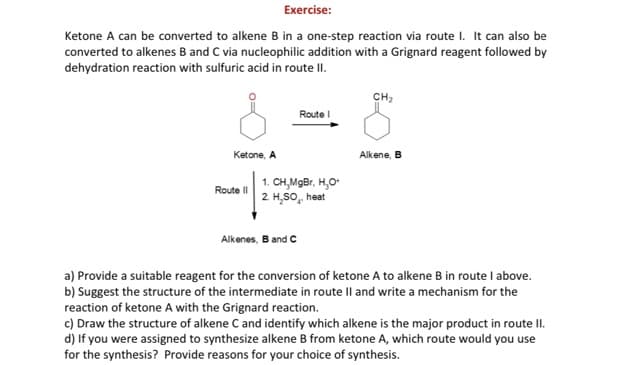Ketone A can be converted to alkene B in a one-step reaction via route I. It can also be converted to alkenes B and C via nucleophilic addition with a Grignard reagent followed by dehydration reaction with sulfuric acid in route II. CH, Route Ketone, A Alkene, B 1. CH,MgBr, H,O 2 H,S0, heat Route I| Alkenes, B and C a) Provide a suitable reagent for the conversion of ketone A to alkene B in route I above. b) Suggest the structure of the intermediate in route Il and write a mechanism for the reaction of ketone A with the Grignard reaction. c) Draw the structure of alkene C and identify which alkene is the major product in route II. d) If you were assigned to synthesize alkene B from ketone A, which route would you use for the synthesis? Provide reasons for your choice of synthesis.
Ketone A can be converted to alkene B in a one-step reaction via route I. It can also be converted to alkenes B and C via nucleophilic addition with a Grignard reagent followed by dehydration reaction with sulfuric acid in route II. CH, Route Ketone, A Alkene, B 1. CH,MgBr, H,O 2 H,S0, heat Route I| Alkenes, B and C a) Provide a suitable reagent for the conversion of ketone A to alkene B in route I above. b) Suggest the structure of the intermediate in route Il and write a mechanism for the reaction of ketone A with the Grignard reaction. c) Draw the structure of alkene C and identify which alkene is the major product in route II. d) If you were assigned to synthesize alkene B from ketone A, which route would you use for the synthesis? Provide reasons for your choice of synthesis.
General Chemistry - Standalone book (MindTap Course List)
11th Edition
ISBN:9781305580343
Author:Steven D. Gammon, Ebbing, Darrell Ebbing, Steven D., Darrell; Gammon, Darrell Ebbing; Steven D. Gammon, Darrell D.; Gammon, Ebbing; Steven D. Gammon; Darrell
Publisher:Steven D. Gammon, Ebbing, Darrell Ebbing, Steven D., Darrell; Gammon, Darrell Ebbing; Steven D. Gammon, Darrell D.; Gammon, Ebbing; Steven D. Gammon; Darrell
Chapter23: Organic Chemistry
Section23.2: Alkanes And Cycloalkanes
Problem 23.2CC
Related questions
Question

Transcribed Image Text:Exercise:
Ketone A can be converted to alkene B in a one-step reaction via route I. It can also be
converted to alkenes B and C via nucleophilic addition with a Grignard reagent followed by
dehydration reaction with sulfuric acid in route II.
CH2
Route I
Ketone, A
Alkene, B
1. CH,MgBr, H,O
2 H,SO, heat
Route II
Alkenes, B and C
a) Provide a suitable reagent for the conversion of ketone A to alkene B in route I above.
b) Suggest the structure of the intermediate in route Il and write a mechanism for the
reaction of ketone A with the Grignard reaction.
c) Draw the structure of alkene C and identify which alkene is the major product in route II.
d) If you were assigned to synthesize alkene B from ketone A, which route would you use
for the synthesis? Provide reasons for your choice of synthesis.
Expert Solution
This question has been solved!
Explore an expertly crafted, step-by-step solution for a thorough understanding of key concepts.
This is a popular solution!
Trending now
This is a popular solution!
Step by step
Solved in 2 steps with 2 images

Knowledge Booster
Learn more about
Need a deep-dive on the concept behind this application? Look no further. Learn more about this topic, chemistry and related others by exploring similar questions and additional content below.Recommended textbooks for you

General Chemistry - Standalone book (MindTap Cour…
Chemistry
ISBN:
9781305580343
Author:
Steven D. Gammon, Ebbing, Darrell Ebbing, Steven D., Darrell; Gammon, Darrell Ebbing; Steven D. Gammon, Darrell D.; Gammon, Ebbing; Steven D. Gammon; Darrell
Publisher:
Cengage Learning

Introductory Chemistry: A Foundation
Chemistry
ISBN:
9781337399425
Author:
Steven S. Zumdahl, Donald J. DeCoste
Publisher:
Cengage Learning

General Chemistry - Standalone book (MindTap Cour…
Chemistry
ISBN:
9781305580343
Author:
Steven D. Gammon, Ebbing, Darrell Ebbing, Steven D., Darrell; Gammon, Darrell Ebbing; Steven D. Gammon, Darrell D.; Gammon, Ebbing; Steven D. Gammon; Darrell
Publisher:
Cengage Learning

Introductory Chemistry: A Foundation
Chemistry
ISBN:
9781337399425
Author:
Steven S. Zumdahl, Donald J. DeCoste
Publisher:
Cengage Learning